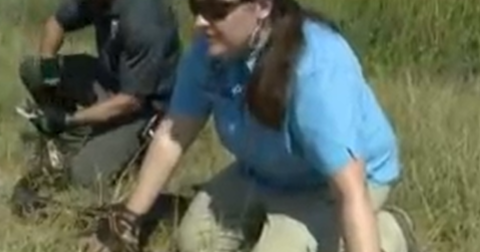Every year, Florida hosts the “Python Challenge.” The 10-day event attracts hunters to the Everglades to help remove the invasive Burmese pythons from the local ecosystem.
It is organized by the Florida Fish and Wildlife Conservation Commission (FWC) in partnership with the South Florida Water Management District and the Fish & Wildlife Foundation of Florida.
Participants, ranging from professional snake hunters to novices, register for the event and undergo required online training to ensure safe and humane removal practices.
The competition offers various prizes, including significant monetary awards, for categories such as the most pythons removed and the longest python captured. In the 2024 challenge, the person or team that killed the most pythons got $2,500, and $1,000 went to the person or team that killed the longest python.
But some hunters capture the snakes year-round.
One woman has caught over 1,000 Burmese pythons
Donna Kalil said she has caught over 1,000 Burmese pythons, and said she can recall exactly where she’s caught each of them.
“All these little blue maps are where I caught. Gives you the date, the time, the size,” Kalil said as she pointed to a map on her phone with markings of where she caught pythons.
And she knows how many she’s missed.
“I wanna say five total. Three that maybe I should have been able to catch. I had my hands on them,” Kalil said.
Professional python hunters contracted by Florida
Kalil is one of a hundred python hunters contracted for the state.
Year-round, she hops in her truck and combs the creeks for them. CBS News Miami and Kalil posted up on what she calls the python perch to try and find one.
“I know I’m making a difference. I know every single python that’s removed is making a positive difference,” she said.
Tens of thousands of pythons in South Florida
The U.S. Geological Survey estimates there are likely tens of thousands of pythons in South Florida.
Michael Kirkland of the South Florida Water Management District oversees the python elimination program, and he said he doesn’t have an estimate on the population.
“It’s such a cryptic species and they’re so well camouflaged and hard to find. Coupled with the fact that the Everglades is a very vast and relatively inaccessible area, we can’t do a conventional population estimate on these species,” Kirkland said.
Kirkland said that because of that, he isn’t certain if the program is making a dent in the population. But he said there are other ways to measure it. He said hunters are catching fewer large pythons lately, and he said the native animal populations that pythons prey on are increasing.
“In some of the advanced natural areas to the park we are starting to see more marsh rabbits. Before it was zero. I’m cautiously optimistic,” Kirkland said.
No Burmese pythons in sight this time
CBS News Miami was unsuccessful in our hunt, and Kalil said she didn’t catch one at all in March. She said the best thing hunters can do is try and stop the population growth at the source.
“When you catch a big female full of eggs, you didn’t catch one python you caught maybe 47,” Kalil said.
Kalil said another way that she measures the python population out here is by concluding that if she can’t find one after searching out here for hours, that may mean there aren’t many of them out here.




